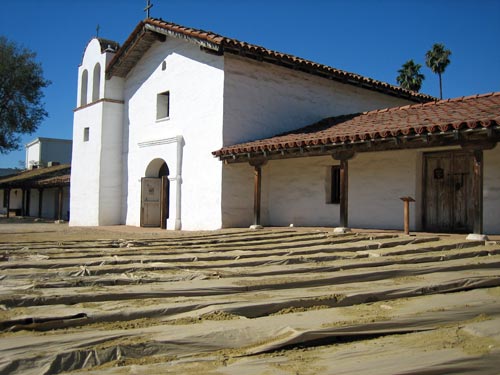
Adobe bricks drying in the sun in front of El Presidio Real de Santa Barbara, which was built in 1782 as a military installation, and the first home of the Spanish in Santa Barbara.
~photo by Kata Polano
So, you want to build your abode with adobe. Ok, I know that doesn’t rhyme, but I still find it a fun coincidence between these two words.
The word adobe comes from the Arabic word al-tob, which means “the brick” and from Coptic tube, which also means “brick”. A brick is precisely what adobe is, a sun-dried brick of clay-soil and sand, with fiber added in some instances as well. These fibers, which add tensile strength, are usually straw, hair, or even horse manure. Yes, I said horse manure! Building with adobe is one of the oldest building techniques in the world, and some of the world’s oldest standing buildings were constructed with adobe.
Once upon a time, in a land far away, there was a group of people who faced the obstacle of building shelter for themselves. All they had was the clay underfoot, and the water from the nearby watering hole. Though I can’t tell you how they determined that mixing the two together, shaping them into rectangles, and stacking them atop one another would give them an amazing building material that was ideal for their situation, but they somehow did.
They probably started without the rectangles, making something more like cob (next article’s topic), and eventually adapted their technique to use bricks. During this time of invention and ingenuity, people also figured out that they could use their horses to mix their mud for them. They would tether the horse to a post in the centre of a shallow pit and have it walk circles around the post. Observations were made that these bricks were much stronger than those made by the people. What was the difference? Yup, you guessed it, the poop! Horse manure not only added strengthening fibers to the adobe mix, it also added an enzyme, which produced a harder and more resistant brick once dry.

Filling the forms for the adobe bricks, which will be used in the restoration of El Presidio Real de Santa Barbara.
~ photo by Kata Polano
Today, adobe continues to be made in a variety of ways, including by foot, horse, and even machine. The mix is poured into forms, and set out in the sun to dry. Forms of various sizes are used to control the size of the bricks; weight and wall thickness are the driving factors in choosing a form size. I, for one, wouldn’t want to lift hundreds of bricks weighing in at 100 lbs each. But hey, it might beat going to the gym.
The wider your brick means the wider your wall, which means more thermal mass of your building. Since adobe buildings are more commonly found in climates that see a lot of sun, and not so much cold and rain, a higher thermal mass makes good sense. A building with high thermal mass slowly absorbs the heat of the sun throughout the day, stores it in its density, and slowly releases it during the cool nights, keeping indoor air temperatures comfortable.
Comfort is also found in the beauty and durability that adobe houses embody. Many adobe walls are kept without a finish plaster on them, with little stones often embedded in the cob mortar for decoration. Other homes receive beautiful finish clay or lime plasters to give smooth, soft surfaces that also add protection from the elements. These finishes can be applied in such a manner that the organic texture of the walls is revieled, or even hidden and flattened out. Whichever your preference, the flexibility of clay and lime finishes can give you what you want while remaining compatible with the natural adobe substrate. But we’ll learn more about finishes in later articles.
I hope you have enjoyed learning about this beautiful ancient building technique that is maintaining its place and functionality in today’s modern world. Stay tuned for my next article, which will take you through the story of cob.
[source: http://feeds.importantmedia.org/~r/IM-greenbuildingelements/~3/KUC9D8wWfrA/]

Leave a Reply
You must be logged in to post a comment.